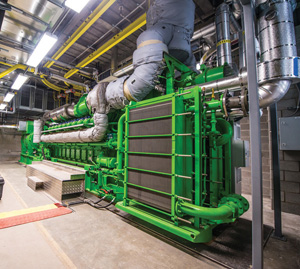It’s still a small share of the whole, and yet reciprocating internal combustion engines are playing a fast advancing role in utility-scale power generation and clean energy grid stabilization, according to a new report from the U.S. Energy Information Administration.
The nation’s capacity in natural gas-fired reciprocating internal combustion engines used to power the grid has grown to more than 4,600 MW--some 20 percent of that deployed in Texas alone, the EIA report reads.
Two states with high wind-energy penetration, Texas and Kansas (564 MW), stand atop the list of those with major reciprocating engine capacity. California is third with close to 400 MW.
 A gas-fired engine in a CHP setup supplied by EPS AB for Enmax in Calgary
Reciprocating internal combustion engines, which typically are used for backup, standby or emergency power, are growing in numbers and capacity despite still being a fraction of those massive gensets used in combined cycle plants. The average reciprocating engine used for gas-fired power is about 4 MW in capacity, but many newer units totaling up to 19 MW have been installed throughout the U.S., according to the EIA.
A gas-fired engine in a CHP setup supplied by EPS AB for Enmax in Calgary
Reciprocating internal combustion engines, which typically are used for backup, standby or emergency power, are growing in numbers and capacity despite still being a fraction of those massive gensets used in combined cycle plants. The average reciprocating engine used for gas-fired power is about 4 MW in capacity, but many newer units totaling up to 19 MW have been installed throughout the U.S., according to the EIA.
The largest of these might be the 225-MW Denton Energy Center in Texas. The Denton power plant includes 12 natural gas-fired Wärtsilä 18.8-MW reciprocating engine generators, which will used to follow the load from renewables and stabilize the grid, according to Burns & McDonnell.
The EIA says that Texas is home to three of the largest gas-fired reciprocating engine plants nationwide. Those include the 220-MW Red Gate near the Mexico border in McAllen, the 202-MW Pearsall near San Antonio and the 164-MW Antelope station near Lubbock.
Texas, not coincidentally, is fast becoming one of the highest wind-energy producers in the world. The state has approximately 23 GW worth of installed capacity and is adding thousands more every year, according to various reports.
Originally published, with permission, February 20 by Power Engineering.
